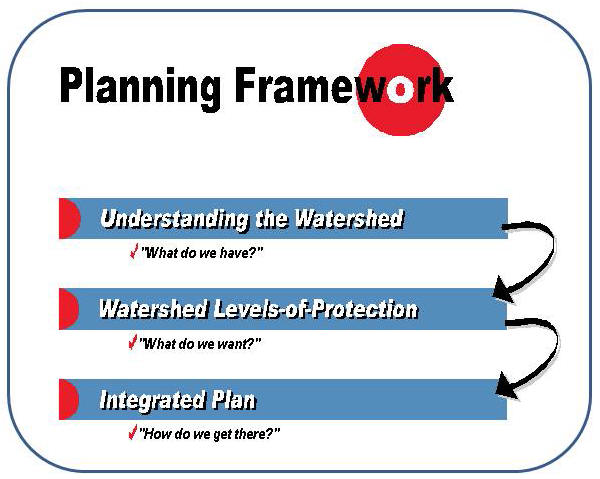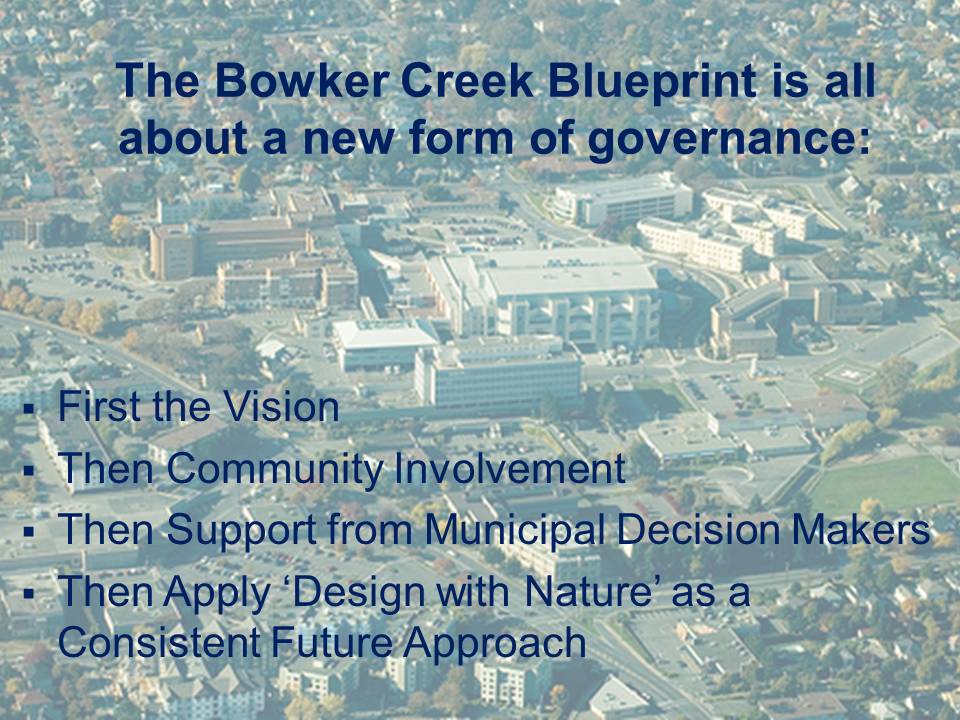Integrated Rainwater Management: Municipalities Can Achieve More With Less
Note to Reader:
In April 2011, Metro Vancouver hosted the 2011 Water Balance Model Partners Forum. This was an opportunity for local governments to learn from each other, and reflect on what can be accomplished through alignment and collaboration. The Water Balance Model is an outcome of collaboration.
The Partners Forum was part of the continuing rollout of Beyond the Guidebook 2010: Implementing a New Culture for Urban Watershed Protection and Restoration in British Columbia.
In the weeks preceding the Forum, the Partnership released a series of articles that foreshadowed the information-transfer that would take place at the Forum. The following is extracted from the fourth in the series.
ISMP Course Correction
A decade ago, local governments were venturing into uncharted waters when undertaking ISMPs, the acronym for Integrated Stormwater Management Plans. Now, the experience of the Bowker Creek Initiative (in the Capital Region) serves as a guide for the “ISMP Course Correction” in the Metro Vancouver region.
The need for a ‘course correction’ was identified by the Metro Vancouver Liquid Waste Management Reference Panel in its Final Report to the Metro Vancouver Board, released in July 2009: “Re-focus Integrated RAINwater/Stormwater Management Plans on watershed targets and outcomes so that there are clear linkages with the land use planning and development approval process.”
Why the Course Correction
“There are two main drivers for the ISMP Course Correction,” states Richard Boase, Co-Chair of the Water Balance Model Partnership. “First, we had observed that too many stakeholders were either unaware or had lost sight of the original purpose in developing an ISMP – which is to  protect stream health. They had also lost sight of what integration means. The second significant driver is the ‘unfunded infrastructure liability’. Local governments are hard-pressed financially. Communities cannot afford the cost of traditional ‘pipe-and-convey’ drainage infrastructure. We are being asked to do more with less.”
protect stream health. They had also lost sight of what integration means. The second significant driver is the ‘unfunded infrastructure liability’. Local governments are hard-pressed financially. Communities cannot afford the cost of traditional ‘pipe-and-convey’ drainage infrastructure. We are being asked to do more with less.”
“Local governments in British Columbia are faced with this challenge: the initial capital cost of infrastructure is about 20% of the life-cycle cost; the other 80% largely represents a future unfunded liability. Fiscal constraints provide a powerful impetus for doing business differently to ‘achieve more with less’.”
Achieve More With Less
 “The elephant in the room is always money. Municipalities have lots of competing interests for spending money; lots of projects to keep staff busy; and finite financial resources. We are all challenged to do more with less and get it done,” stated Anne Topp, District of Saanich Manager of Community Planning, at the 2010 Bowker Creek Forum, held in Victoria.
“The elephant in the room is always money. Municipalities have lots of competing interests for spending money; lots of projects to keep staff busy; and finite financial resources. We are all challenged to do more with less and get it done,” stated Anne Topp, District of Saanich Manager of Community Planning, at the 2010 Bowker Creek Forum, held in Victoria.
“We all have heard the quote ‘if you don’t know where you are going, it doesn’t matter what road you take’. With completion of the Blueprint, the Bowker Creek Initiative knows where it wants to go. Integrating with and using other plans to advance the Blueprint will be ongoing.”
“The 100-year Action Plan gives us time. This plan is not just about water. It is about how this community wants to live and connect to the environment. We don’t have to do the $20 million, $40 million ISMP approach. Keeping the pieces small and creating bite-sized pieces should allow the slow and steady approach,” concludes Anne Topp.
To Learn More:
To download a PDF version of the complete article below, click on Integrated Rainwater Management: Municipalities Can Achieve More With Less .
The focus of the artlcle is on the ISMP Course Correction. It describes the drivers for doing business differently; provides an overview of how the times have changed; and introduces the precedent-setting Bowker Creek Blueprint.
 To understand the Bowker Creek context, click on The Bowker Creek Blueprint demonstrates what can be accomplished through a vision, alignment and collaboration — “Based on my experience over the past 30-plus years, the Bowker Creek Blueprint has gone well beyond any other plan in terms of how it has achieved consensus and galvanized commitment to move from planning to action on the ground,” states Kim Stephens, Executive Director of the Partnership for Water Sustainability.
To understand the Bowker Creek context, click on The Bowker Creek Blueprint demonstrates what can be accomplished through a vision, alignment and collaboration — “Based on my experience over the past 30-plus years, the Bowker Creek Blueprint has gone well beyond any other plan in terms of how it has achieved consensus and galvanized commitment to move from planning to action on the ground,” states Kim Stephens, Executive Director of the Partnership for Water Sustainability.



